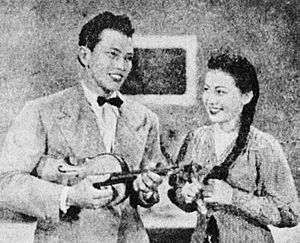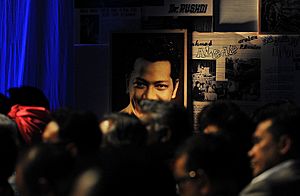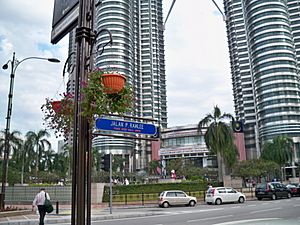P. Ramlee facts for kids
Quick facts for kids
Yang Berbahagia Tan Sri Datuk Amar
P. Ramlee
PSM DA AMN
|
|
|---|---|
| ڤي رملي | |
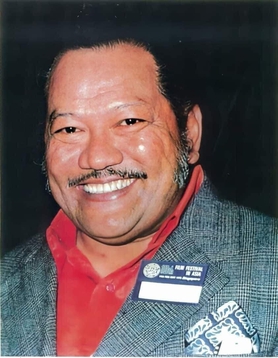
P. Ramlee at the 19th Asia-Pacific Film Festival, 1973
|
|
| Born |
Teuku Zakaria bin Teuku Nyak Puteh
22 March 1929 Penang, Straits Settlements, British Malaya (now Malaysia)
|
| Died | 29 May 1973 (aged 44) Kuala Lumpur, Malaysia
|
| Resting place | Jalan Ampang Muslim Cemetery, Kuala Lumpur |
| Monuments | P. Ramlee Memorial |
| Other names | Ramlee Puteh |
| Education |
|
| Occupation |
|
| Years active | 1945–1973 |
|
Notable work
|
|
| Spouse(s) |
Junaidah Daeng Harris
(m. 1950; div. 1955)Noorizan Mohd. Noor
(m. 1955; div. 1961) |
| Children | 7 (including Nasir) |
| Musical career | |
| Genres | Pop |
| Instruments |
|
| Labels | EMI |
| Signature | |
P. Ramlee was a super talented Malaysian artist. He was an actor, filmmaker, musician, and composer. Born as Teuku Zakaria bin Teuku Nyak Puteh (later Ramlee bin Puteh), he became famous in Malaysia, Singapore, Indonesia, and even Southern Thailand. He is seen as a huge icon of Malay entertainment because of his amazing work in movies and music. His popularity even reached Brunei, Hong Kong, and Japan!
Contents
His Early Life
P. Ramlee was born on March 22, 1929. His father, Teuku Nyak Puteh, came from a rich family in Aceh, Indonesia. He moved to Penang, Malaysia, and married Ramlee's mother, Che Mah Binti Hussein.
Ramlee went to a few schools, including Sekolah Melayu Kampung Jawa and Penang Free School. His father registered him as "Ramlee" because his original name, Teuku Zakaria, was a bit unusual for other kids at that time. He was a bit naughty as a student, but he loved music and football.
His studies were stopped when the Japanese occupied Malaya from 1942 to 1945. During this time, he joined a Japanese navy school. He also learned basic music and Japanese songs from his teacher. After the war, he took more music lessons and learned to read music notes.
Why His Name Changed
P. Ramlee got his stage name by shortening his father's name, Puteh, to "P." and adding it to his own name, Ramlee. This was similar to how some people in India use their father's name as an initial.
His Amazing Career
By 1948, when he was 19, Ramlee had already won many singing contests. He also wrote his own songs and played the violin in a band. A film director named B. S. Rajhans discovered him at a singing competition.
Ramlee got a small role in the film Chinta ("Love") in 1948. He played a bad guy in the movie. He also sang five songs for the main actor, even though he wasn't seen singing on screen.
Becoming a Star
In 1950, Ramlee got his first main role in the film Bakti ("Devotion"). He was the first actor to sing in his own voice in a Malay film! In later movies like Juwita (1951) and Ibu ("Mother") (1953), he became a big star. Between 1948 and 1955, he acted in 27 films.
A Talented Songwriter
Besides acting, Ramlee was a fantastic songwriter. He wrote about 500 songs, and 359 of them were recorded by him for his films and albums. Some of his most famous songs include "Getaran Jiwa", "Dendang Perantau", and "Azizah". His songs were often used in his movies, sung by him or other artists. He even won an award for best music in the film Hang Tuah at the Asia-Pacific Film Festival.
Directing Great Films
P. Ramlee started directing movies in 1955. His first directed film was Penarek Becha ("Trishaw Man"). This movie was called the best Malay film of that year! He also directed and starred in the funny Bujang Lapok comedy series. One of these, Pendekar Bujang Lapok, won the Best Comedy award at the Asia-Pacific Film Festival. He also won Best Actor for Anak-ku Sazali at the same festival. Other important films he directed include Antara Dua Darjat, Ibu Mertua-ku, and Tiga Abdul.
The years between 1955 and 1964 were his "golden age." During this time, he made his most famous films and wrote his best songs. In 1964, he moved from Singapore to Kuala Lumpur to make films with another company. He made 18 more films there. His very last film was Laksamana Do Re Mi. His last song was "Ayer Mata di Kuala Lumpur" ("Tears in Kuala Lumpur"). In total, Ramlee acted in 62 films and directed 33!
His Lasting Legacy
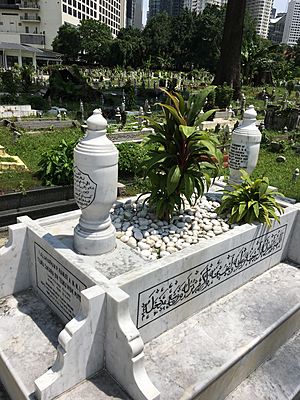
P. Ramlee passed away on May 29, 1973, at the age of 44, due to a heart attack. He was buried in Kuala Lumpur.
How He is Remembered
Even after his death, P. Ramlee's contributions are still celebrated.
- In 1986, a memorial called the P. Ramlee Memorial was built in his home in Kuala Lumpur.
- In 1982, a street in Kuala Lumpur was renamed Jalan P. Ramlee in his honor.
- He was given the special title "Tan Sri" in 1990 and "Datuk Amar" in 2009. These are very high honors in Malaysia.
- His childhood home in Penang is now a museum called the P. Ramlee House. You can see his personal items and family belongings there.
- On his 88th birthday in 2017, Google honored him with a special picture (a Google Doodle) on their Malaysian homepage.
- In 2021, KFC even created a special menu item, the "Burger P. Ramlee," inspired by his favorite dish!
Films and Awards
His Many Films
P. Ramlee was involved in almost every part of filmmaking. He wrote scripts, directed, acted, composed music, and sang. He acted in 62 films and worked on many others in different roles throughout his career.
Awards and Honors
P. Ramlee received many awards and honors for his amazing work:
- From Malaysia:
- He was given the title "Member of the Order of the Defender of the Realm" (AMN) in 1962.
- He was given the high title "Commander of the Order of Loyalty to the Crown of Malaysia" (PSM), which comes with the title Tan Sri, in 1990 after he passed away.
- He was also given the special name Seniman Agung, which means "Great Artist."
- From Sarawak:
- He was given the title "Knight Commander of the Order of the Star of Hornbill Sarawak" (DA), which comes with the title Datuk Amar, in 2009 after he passed away.
Places Named After P. Ramlee
Many places have been named after P. Ramlee to remember his legacy:
- Jalan P. Ramlee in Penang (renamed in 1983)
- Jalan P. Ramlee in Kuala Lumpur (renamed in 1982)
- Bangunan P. Ramlee and Bilik Mesyuarat Tan Sri P. Ramlee at Sekolah Kebangsaan Hulu Klang
- Jalan P. Ramlee in Kuching, Sarawak
- Taman P. Ramlee, a neighborhood in Kuala Lumpur and George Town, Penang
- Pawagam Mini P. Ramlee at Studio Merdeka, FINAS
- Makmal P.Ramlee at Filem Negara Malaysia
- P. Ramlee Auditorium (formerly RTM Auditorium) at Angkasapuri
- SK Tan Sri P. Ramlee, his old school in Georgetown, Penang (renamed in 2011)
- Ramlee Mall at Suria KLCC shopping center in Kuala Lumpur
- Bukit Nanas Monorail station in Kuala Lumpur, which used to be called P. Ramlee Monorail station
- Auditorium P. Ramlee, RTM Kuching, Sarawak


